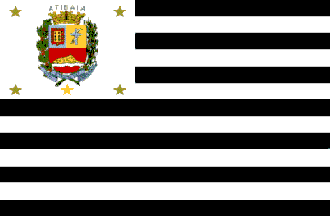 by Blas Delgado Ortiz
by Blas Delgado Ortiz
Last modified: 2002-07-13 by joe mcmillan
Keywords: sao paulo | brazil | atibaia | stripes:13 | stripes (black) | stripes (white) | canton (white) | stars (gold) |
stars: 5 |
Links: FOTW homepage |
search |
disclaimer and copyright |
write us |
mirrors
The flag of Estância de Atibaia is composed of a white canton bearing the
town coat of arms and four stars at each corner of the canton, and 13 black
and white stripes. The canton is the height of 5 stripes.
Dov Gutterman, 28 January 1999
A URL with both the flag and the coat of arms is http://www.camaraatibaia.sp.gov.br/brasao/index.htm. It includes the following info:
The author of the city arms, created by municipal law no. 282 of 21 June 1954, was Enzo Silveira. The first field, silver, represents the arms of the Camargo family, to evoke Jerônimo de Camargo. The second field has a cross with a flag and the inscription Ecce Agnus Dei, evoking St. John the Baptist, patron of the city. The third field has a mountain range, proper, the range of Itapetinga. The silver scroll represents the river Atibaia. Among the outer symbols, the golden mural crown represents the opulence of the municipality, the doublet represents Atibaian bandeirantism, the branch of coffee is source of the city's first wealth, and the sheaf of wheat represents the time when extensive culture of this cereal was developped. The motto Ouvi o tropel das bandeiras ("hear the hubbub of the flags") talks of the deeds of the Paulista bandeirantes in the territory of Atibaia.>Jorge Candeias, 28 January 1999The flag of Atibaia was created by law no. 837 of 23 March 1965, and is white with seven black horizontal stripes, representing the places that had been independent but were integrated in the Atibaia municipality. They are: Bragança Paulista, Piracaia, Joanópolis, Nazaré Paulista, Bom Jesus dos Perdões, Jarinu and Atibaia. In the upper right (hoist) corner of the flag is the coat of arms, and in the four corners close to the arms and in the lower centre are five stars that evokes the Atibaian heroes who died in war in São Paulo in 1932 and in Italy in 1939. Each star represents a hero.